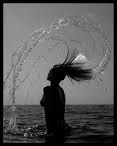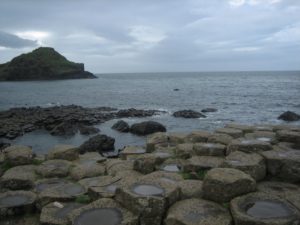 I was beautiful. The very cold, round rocks were slipping under my feet. The freezing Maine morning had risen, and my nightgown was like a new garment to me: I was beautiful. I was twelve.
I was beautiful. The very cold, round rocks were slipping under my feet. The freezing Maine morning had risen, and my nightgown was like a new garment to me: I was beautiful. I was twelve.
That summer my mother (a person born and raised in the arid rocky mountains in Colorado) woke us up as many mornings as she could to share the sunrise. And, we, like heavy, uninterested Brooklynites, often indulged her. We would get out of bed, go to the large window facing directly out to the sea, look at the sun wrenching itself up above the cold sea, smile at our wistful matriarch, then swivel and go back to bed.
I don’t know why I woke up that one morning at the first start of sunrise. I simply got up and went to the water without shoes or a coat. It was cold that summer (or is it always in Maine?) and I knew that could catch a cold. I guess I was awoken from the inside, to go outside.
Over the past few months I have been writing about an installation called “Plastic Century” www.plasticcentury.org. The piece premiered June 3rd at the California Academy of Sciences, and will be shown again June 10th. I’ve been in the presence of some lovely, open partners who are all men. I’ve been thinking a lot about plastics so we could make a piece about their rise in production. I’ve not been feeling beautiful. Actually, I’ve had little awareness of my body (oddly) as we have built it: an installation about the growth of plastics in relation to a century of production (one where Cousteau was born, 1910 projecting to 2030). I’ve been thinking about the earth and water and about health. But, not beauty.
This sort of makes sense, since it was only a few years ago that my dear friend and I made a vow to get liposuction at 40. Ok, that’s so politically incorrect that at this moment it even startles me. But, that’s the fact. A few years ago I thought I could take the pain (how bad could it be?), have all that old, unneeded fat taken out, and then mystically be refilled with the tonality of the body I had as a dancer at 21. Oh, and did I mention the boob job? No? That was a great idea. It was not going to be implants but a tuck (with some help) for it had been been said that I had in the past (note the wistful use of “had” and “past” here) been told I was “Cerubic”. Well, when you have a child, a strong, little man of a boy who nurses ,you go from Cherubic to…oy…your aunt Bertha.
So, come on, we said – we’ll get “done” – we’ll get a “refresh”: we’ll make clean slate of it.
What is that clean slate? What gives us that time back, that time – that crazy past when even then we thought we were not skinny enough? I have found no answer to that…and have in fact come to see that positioning of anti-plastic surgery to not quite hitting the mark yet. The general reason given today (in the mass media) not to get surgery is presented this way:
– Youth isn’t everything
– Your health MIGHT suffer
– You are beautiful the way you are.
Over the past months as we’ve been faced with the facts of exponential plastic production -6 Billion tons since 1910-2010- http://plasticcentury.com/history.html I have also had to face myself. My sense of sadness that the thing I never told a soul about (only my friend) that there was a crazy plan (unafordable of course!) where plastic surgery was going to take the weight off of my aging, is not longer an option for me.
One of the most difficult things about coming to terms with letting go of plastic in our lives (above and beyond what we perceive to be convenience of straws, lids, tupperware, etc) are the really strange, huge promises for plasticine renewal – for our bodies to be made in the image of our imagination. And, though it’s easy to say that that “imagination” is the beauty industry trying to make a buck off our insecurities, I believe there is a deeper, more layered reality: we have become deeply engaged with the idea that a woman can, and should be poisoned, since her body is valuable only in a state of beauty.
This makes it more complicated because we women have bought into this idea – yes, because it’s been sold to us – but also because we have come to believe that it’s possible that our bodies are not our own. They couldn’t be ours if we are willing to poison them? Or,have them cut into? Or, believe (as I allowed myself to believe) that the physical pain would be worth the skinny jeans. Whose bodies are these? I’m of the generation that read, “Our Bodies Ourselves” – it should be unthinkable for me to have thought I’d do Lipo – but this wonderful title may not be the right one anymore. Perhaps we should have it be, “Our Body is the Earth”.
What would that mean if said our bodies were also a part of the earth? It raises an interesting question. First, we’d have to believe that we are a part of the interconnected growth and death of the planet. Second, we’d have to believe that as women what we put into ourselves, slather ourselves with, shave and primp and fill ourselves with silicone, directly impacts the health of the planet. IF we thought this way, really felt this connection (not just the often mystic or connected way women have experienced the planet) a connection to our direct harm of the earth, through the harm our ourselves, it might be a painful but important shift.
So, what would the mandate of the new anti-plastic surgery be then? Perhaps this:
– Your body filled with plastic will never leave the planet
– Your body covered in and filled with plastic is poisoning you – and the planet
– Your body IS your own – and the planet is part of your body.
The installation was this past Thursday. The next day I was exhausted so I paid a nominal fee to sit in the Japanese communal baths of the Kabuki Hot Springs here in San Francisco. There are days that are co-ed and people wear bathing suits while they sit in the sauna, steam room, hot back and then lie down on cool wood planks to rest. On Friday it was the woman’s day and some people were in bathing suits, yet most were not. And, as usual I collapsed in the sauna and steam rooms. I kept a cool towel over my eyes and drank water. I was alone in myself. Until, I went to sit in the hot bath.
And, then, there they were. Two woman were in the hot bath (which when standing the water comes to below your butt). One woman was standing with her back to us, the other was sitting with her back leaning on the wall. Now, mind you, there is very little sexy about a Japanese bath – it’s vibe is silent and meditative and people keep their gaze to themselves. Though, I broke all the rules of the gaze.
The woman standing was speaking in sign language to her friend and her friend was nodding vigorously. The woman standing had tatoos on her, but the markings looked like braille on her arms and a design that seemed similar by her hip. She was covered in her own language, and her gestures were vibrant, and perhaps gossipy, or simply stating some critical facts. Her friend kept responding as the standing woman kept dunking herself into the water, without stopping her signing, without missing a beat! I looked around and saw we all were all mesmerized. Why? Because the woman was profoundly beautiful. Her shape? No, it was her complete immersion of herself, into herself, into the water, into the planet of her communion with her friend.
I watched her speak, and dance with her hands and admired her comfort with her body. And, as a part of the water she was in, I was a part of the silent, owned dialogue of a body untouched by anything plastic – only her choice to be marked, like a warrior, with words she had chosen.
I closed my eyes. I tried to imagine the sea again. I thought of a time when I did not know I could be “made better”. I tired to pretend I had never known that women die from implants. I tried to find the humor that I still want a smaller ass.
And, perhaps it was the sound of water lifting off of that silent speaking woman, it’s quick rush and splash, that I was reminded of Maine: the rocks, the cold, the path of the water from me to the sea. I felt it for a moment, that memory of looking out at the ocean and knowing that out there there was something called being a woman, and that in there, that child’s body there was only beauty.

Sarah E. Kornfeld is a writer and hybrid communications executive for those innovating in art/ social sharing/biosphere/and neuroscience initiatives. Her blog on trends and creative visions is widely read: what sarah sees . Born and raised in the theater, Sarah’s worldview is shaped by creation in public spaces. She’s deeply passionate about applied neuroscience and it’s impact on policy and place, how art and international issues intersect, and her groovy seven year old son.
Sarah works with The George Greenstein Institute, The Institute for the Future, Bluemind/Liveblue and other organizations bridging the mind, planet and health issues. She was an original member of the producing team for Dancing in The Streets, which placed dance in public places around the world: Grand Central Station, The Brooklyn Bridge, Place de Concord/Paris, the Tiber River/Rome. She is finishing her first novel.









